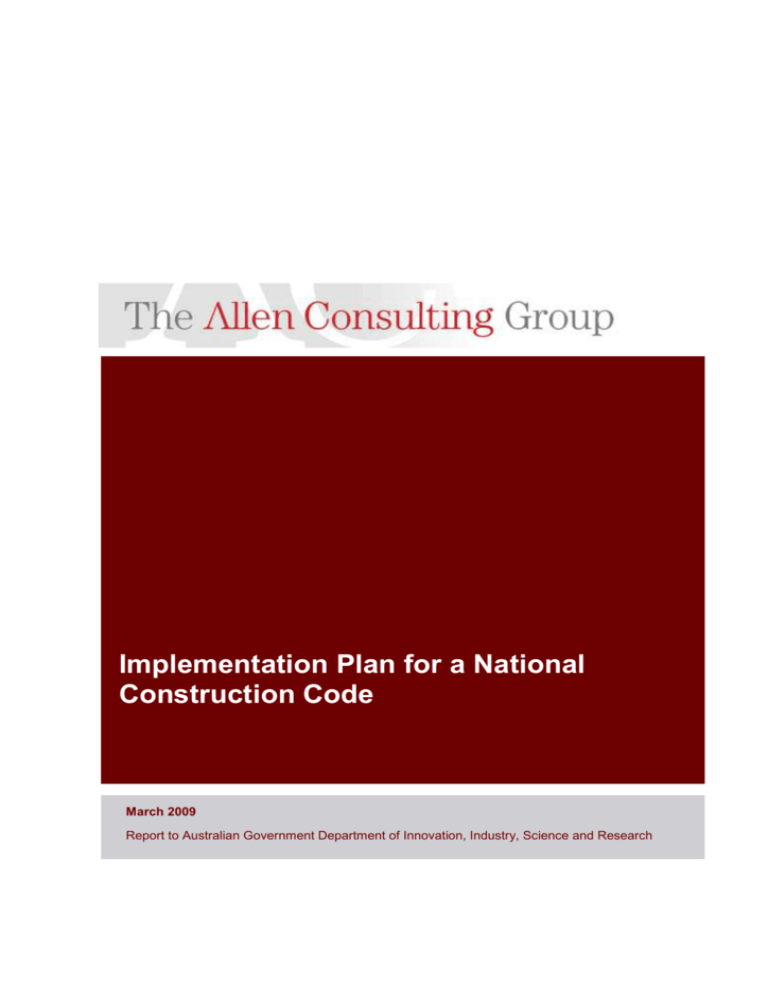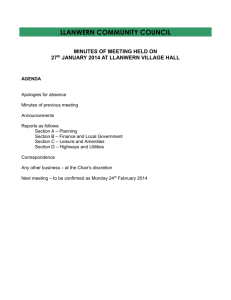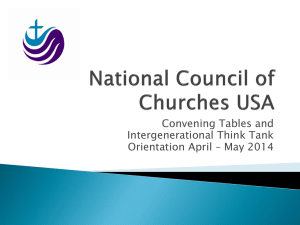Implementation Plan for a National Construction Code
advertisement

Implementation Plan for a National Construction Code March 2009 Report to Australian Government Department of Innovation, Industry, Science and Research The Allen Consulting Group Pty Ltd ACN 007 061 930, ABN 52 007 061 930 Melbourne Level 9, 60 Collins St Melbourne VIC 3000 Telephone: (61-3) 8650 6000 Facsimile: (61-3) 9654 6363 Sydney Level 12, 210 George St Sydney NSW 2000 Telephone: (61-2) 8272 5100 Facsimile: (61-2) 9247 2455 Canberra Empire Chambers, Level 2, 1-13 University Ave Canberra ACT 2600 GPO Box 418, Canberra ACT 2601 Telephone: (61-2) 6204 6500 Facsimile: (61-2) 6230 0149 Perth Level 21, 44 St George’s Tce Perth WA 6000 Telephone: (61-8) 6211 0900 Facsimile: (61-8) 9221 9922 Online Email: info@allenconsult.com.au Website: www.allenconsult.com.au Disclaimer: While The Allen Consulting Group endeavours to provide reliable analysis and believes the material it presents is accurate, it will not be liable for any claim by any party acting on such information. © The Allen Consulting Group 2008 The Allen Consulting Group ii Contents Chapter 1 1 Overview of NCC implementation stages 1 1.1 NCC implementation stages and timeframe The Allen Consulting Group 2 Chapter 2 4 Stage 1: Development of the NCC 4 2.1 State and Territory agreement on approach to consolidation 4 2.2 Consolidation of building and plumbing technical standards 5 2.3 Stakeholder consultation on Consolidated NCC 8 2.4 Ministerial endorsement of NCC 9 2.5 Publish NCC 9 Chapter 3 10 Stage 2: Agree the NCC IGA 10 3.1 Process for agreeing the NCC IGA 10 3.2 Key elements of a NCC IGA 11 Chapter 4 15 Stage 3: State and Territory implementation of the NCC 15 4.1 Legislative amendments 15 4.2 Administrative changes 19 4.3 Communication and education 20 Chapter 5 22 Stage 4: On-going integration and harmonisation 22 Chapter 6 23 Implementation risks 23 Appendix A 24 Potential models for NCC implementation — NSW example 24 Appendix B 25 References 25 iii IMPLEMENTATION PLAN FOR A NATIONAL CONSTRUCTION CODE Chapter 1 Overview of NCC implementation stages This document provides an implementation plan for a National Construction Code (NCC). It will be provided to the Business Regulation Competition Working Group (BRWCG) for its endorsement and then to the Council of Australian Governments (COAG) for consideration, along with a Consultation Regulation Impact Statement (RIS) on a NCC. This plan sets out the key tasks to be completed (with approximate timeframes) for government to implement a NCC, and a supporting Intergovernmental Agreement (IGA). In addition to the stages and milestones set out in this plan, implementation of a NCC would take into account: recommendations from the current review of the IGA for the Australian Building Codes Board (ABCB), which will establish a preferred model for a NCC IGA outcomes from the final RIS, approved by COAG and the Office of Best Practice Regulation (OBPR), which needs to demonstrate that a NCC will provide a net benefit to the community. The IGA review report, NCC RIS and NCC implementation plan are the three key deliverables of the work that the Australian Government Department of Innovation, Industry, Science and Research (DIISR) commissioned Allen Consulting Group (ACG) to undertake. These project elements and timeframes for their completion are set out in Figure 1.1 below. The Allen Consulting Group 1 IMPLEMENTATION PLAN FOR A NATIONAL CONSTRUCTION CODE Figure 1.1 REVIEW OF IGA AND NCC IMPLEMENTATION Review Questions Reporting How should a NCC be implemented? (Transition, legislative and admin changes) Draft NCC Implementation Plan What are the costs and benefits of a NCC over other options? (Legislative and admin, technical changes, compliance costs) How does the IGA need to change to manage a NCC and other future challenges? Is the current IGA effective? How can it be improved? Draft NCC RIS April 2009 for COAG consideration IGA Review progress report NCC implementation plan April 2009 Full IGA Review report March 2009 Final RIS following stakeholder comment 1.1 Timing Finalised July 2009 NCC implementation stages and timeframe The overall task of implementing a NCC can be separated into four stages. Figure 1.2 provides a representation of each stage and its approximate timeframes. Final timeframe for the implementation of the first NCC will depend on the approach to consolidation of codes agreed by governments. The requirements of each stage are discussed in the following chapters of this implementation plan. The Allen Consulting Group 2 IMPLEMENTATION PLAN FOR A NATIONAL CONSTRUCTION CODE Figure 1.2 STAGES IN IMPLEMENTATION PLAN BRCWG STAGE 1: Prepare NCC Round table COAG Consolidation Option 1 endorse COAG of S&T reps endorse draft IP note IP agree on cons. for NCC for NCC consolidation approach approach for 1st for 1st NCC STAGE 2: Agree New IGA Public consulted Consult Ministers sign-off (BMF&P) Publish Key : NCC IP - implementation plan S&T - State and Territory Consolidation Option 2 NCC Minister agreement on review outcomes IGA review outcomes Draft NCC S&T reps Draft NCC COAG endorse parameters for new IGA S&T reps Public Ministers consulted Consult sign off (BMF&P) Develop/draft new IGA STAGE 3: State and Territory Adjustment to NCC Publish NCC BMF & P - Building Ministers f orum and Plumbing Minsters Mnisters sign off (BMF & P) State and Territory amendments to : administrative arrangements legislative arrangemements transitional arrangements State/based industry/Public consultation STAGE 4: Ongoing work integrating NCC Industry/regulator Training Ongoing harmonisation and integration in subsequent versions of the NCC M A M J J A 2009 S O N D J F M A M J J 2010 A S O N D J F M A M J 2011 S The Allen Consulting Group 3 DRAFT IMPLEMENTATION PLAN FOR A NATIONAL CONSTRUCTION CODE Chapter 2 Stage 1: Development of the NCC The development of the NCC document itself (the technical standard) is the first stage of NCC implementation, following BRCWG endorsement and COAG sign off of the implementation plan. As shown in Figure 1.2, this stage will be conducted concurrently with the development and agreement of a new IGA (as discussed in the next chapter). It is important to establish a process for developing and agreeing a technical standard, as separate from governance, funding and administration. Stakeholders consulted on NCC implementation supported this approach, noting that a lesson learned from the BCA development process was that technical and administrative issues should be considered separately during the development process. This stage will involve: agreement from governments on the structure of the NCC and the approach to consolidating building and plumbing codes, through a roundtable of Commonwealth, State and Territory government representatives an initial consolidation of technical standards, to be conducted by a small group of technical experts consultation on the consolidated code with State and Territory government representatives, followed by full public consultation endorsement of the NCC by relevant Ministers (the Building Ministers Forum [BMF] and Ministers responsible for plumbing, where not on the BMF) publication of the new NCC. The outcome from this stage will be the first consolidated NCC. It will not address how it will be governed (Stage 2) or how each State and Territory will implement the NCC in their own legislation and administration (Stage 3). 2.2 State and Territory agreement on approach to consolidation Prior to starting consolidation, there needs to be an agreement from Commonwealth, State and Territory governments about the structure and regulatory approach of the new Code. This should be done through a roundtable of representatives of plumbing and building regulators from each State and Territory, and a representative from the Commonwealth. The outcome from this process should be agreement on: The Allen Consulting Group the objective of the NCC the regulatory approach (i.e. performance-based or prescriptive) coverage of the NCC the structure and format of the first consolidated version of the NCC — specifically, how the two sets of technical codes should be consolidated. 4 IMPLEMENTATION PLAN FOR A NATIONAL CONSTRUCTION CODE Consultations for this review tested stakeholder views on these aspects of NCC implementation. Government and industry stakeholders consulted on NCC implementation strongly support maintaining the current performance-based approach and structure of the BCA and PCA, as set out in Figure 2.3. This should be the starting point of the NCC. Figure 2.3 BCA FRAMEWORK Source: ABCB 2008 Stakeholders provided a number of suggestions on the format of the first consolidated version of the NCC. There was a case made, on practical grounds, for a third volume of the BCA covering plumbing standards. While some questioned whether this approach would adequately achieve the benefits of consolidating building and plumbing standards into one code, it does assist practitioners who may only need to reference the plumbing standards. A third volume allows plumbers to focus on those aspects for which they are responsible, similar to how housing provisions are set out separately in volume 2 of the BCA. Another suggested option for formatting a NCC was to have a ‘Section K’ in the NCC for plumbing. This would help to integrate building and plumbing codes by using common definitions and standards references. Under this suggestion, each NCC section could be sold separately to allow specialist trades/professions to not have to purchase the entire code. 2.3 Consolidation of building and plumbing technical standards Once the overall structure of the first NCC is agreed, work on the consolidation can commence. The process of bringing together codes should be conducted by a small group of building and plumbing technical experts, convened by DIISR. This group may include individuals from ABCB, State and Territory regulators or industry; however, it would not be a representative body. The intention would be to review current technical standards and develop a consolidated code for stakeholder comment and, ultimately, Ministerial endorsement. Though, the group will not have the authority to either publish or seek comment on any NCC matters without the signoff under the existing frameworks of the BCC, ABCB and the Plumbing Regulators. The Allen Consulting Group 5 IMPLEMENTATION PLAN FOR A NATIONAL CONSTRUCTION CODE The extent of this consolidation work will depend on the outcome from the previous stage. Broadly speaking, there are two potential options: Option 1 — a simple addition of the PCA to the BCA as a separate volume, make little if any changes to the two individual codes but with the view to addressing issues of consistency and overlap in subsequent versions of the NCC (‘Option 1’ in Figure 1.2) Option 2 — a more substantial consolidation which aims to merge the two codes including identifying and addressing areas of inconsistency and overlap prior to publishing the first version of the NCC. This second option would require more time than the first (‘Option 2’ in Figure 1.2). The advantage of the first option is a short implementation period for the first version of the NCC, whereas the second option would require around 12 months additional work in consolidating codes. That said, the second option would provide, in the first version of the NCC, a code with fewer areas of overlap and inconsistency and would be more in keeping with the objective of creating a NCC. Implementing either of these options would still require an assessment of the most appropriate plumbing standards to be consolidated with the BCA. The additional step would be identifying areas of overlap and inconsistency whilst merging the two documents. Both of these tasks are discussed below. The Business Regulation and Competition Working Group meeting on 13 March 2009 agreed to recommend Option 2 to COAG for its endorsement. Agree ‘base code’ for plumbing standards Not all States and Territories currently use the PCA as their plumbing standard. The coverage of the PCA is set out in Table 2.1. Three jurisdictions do not reference the PCA, instead referencing either the relevant Australian Standard (AS/NZS 3500) directly (NT and WA) or referencing their own code based on AS/NZS 3500 (NSW). This is the key point of difference between the current building and plumbing regulatory frameworks — building, through the BCA, is more progressed in having a single code that is referenced by all jurisdictions (albeit with some variations). The Allen Consulting Group 6 IMPLEMENTATION PLAN FOR A NATIONAL CONSTRUCTION CODE Table 2.1 ADOPTION OF THE PLUMBING CODE OF AUSTRALIA Jurisdiction Adopted the PCA? ACT Yes, Parts A, B, C and G. QLD Yes, Parts A, B, C and G. The Queensland Plumbing and Wastewater Code prevails over the PCA in cases of inconsistency. SA TAS Yes, Parts A, B, C, F2 and G. Yes, the Tasmanian Plumbing Code references and varies the PCA. Victoria Yes (in Plumbing Regulations 2008), Parts A, B, C, D (with restrictions), E and G. NSW No. The various agencies responsible for plumbing regulation in the State call up the New South Wales Code of Practice for Plumbing and Draining. This document adopts ‘AS/NZS 3500:2003 and amendments and Part 5 2000’. NT No. The Territory’s Building Regulations call up AS/NZS 3500 ‘published by the Standards Association of Australia as amended from time to time.’ WA No. The State’s regulations call up AS/NZS 3500:2003 Parts 1, 2 and 4. Source: ACG research of relevant legislation, regulation and codes, supported by stakeholder consultations The process of consolidating building and plumbing codes therefore requires two stages: first, agree what that ‘base code’ will be for plumbing standards (effectively what has already been achieved for building through the BCA), second, consolidate this with building standards. The ‘base code’ will effectively be the minimum technical standards that each State and Territory will commit to referencing in their legislation, in the form of a NCC (this commitment forming part of the new IGA). The PCA does provide an excellent starting point in this process. However, it will be necessary, to assess the extent to which the current PCA is most appropriate to be the key plumbing reference in the NCC given that three States/Territories do not currently reference it at all. This process will need to identify: The Allen Consulting Group those parts of the PCA which will be reflected in the NCC. This is important to consider given that, of those jurisdictions that reference the PCA, none reference all Parts (as noted in Table 2.1). In particular, only one jurisdiction references Section D, E and F fully (though South Australia references Section F2). It may be that these are not required in a NCC. the extent of variations to the PCA in State and Territory legislation, and whether these should be reflected directly in the NCC or continue to be State and Territory based variations to the NCC. For instance, where there are particular aspects of the PCA that are varied by several jurisdictions there may be a case for amending the standard to reflect this. 7 IMPLEMENTATION PLAN FOR A NATIONAL CONSTRUCTION CODE This process will assist in identifying the most appropriate aspects of the PCA to bring across to the NCC. As the PCA is not currently subject to the annual review process, it is likely that some adjustments to the PCA will be required prior to consolidation into the NCC. That said, at this stage, the intention would not be to achieve agreement from States and Territories on a single plumbing code. Rather this set of requirements, as the ‘base code’ for plumbing, would form the foundation of the NCC that would be implemented by States and Territories over the transition period. 2. Identify and consolidate areas of overlap and cross-referencing The amount of consolidation of the BCA and PCA will depend on the decision made by the State and Territory representative roundtable. If the first option is taken, to simply add the PCA to the BCA, the consolidation steps would be the minimum necessary, i.e. to ensure that there is no direct conflict between the two documents and to ensure consistent nomenclature etc. If the second option is taken, to undertake a more substantial consolidation of the two codes then consolidation would include identifying areas of overlap and crossreferencing. In consultations on the NCC implementation, stakeholders indicated that the key areas of overlap were stormwater and drainage systems, heating ventilation and air conditioning and some heated water energy efficiency requirements. There is also overlap in relation to installation for disability access (under AS 1428). Where there are areas of overlap, the consolidation of standards need to establish the appropriate standard that should be used, and ensure that this is consistent throughout the code. Consolidation of plumbing and building codes should produce a document that has: appropriate coverage, including appropriate coverage of sustainability and accessibility (the key emerging issues raised by stakeholders) a consistent regulatory style (as a performance-based standard) internally consistent terms in its cross referencing between building and plumbing parts, and references to external standards consistent nomenclature throughout. Note that this version of the code is unlikely to fully achieve the objective of having measurable performance standards, which is currently an on-going process of revision to the BCA. This objective should, however, be maintained and progressed under a NCC framework. 2.4 Stakeholder consultation on Consolidated NCC Once the exposure draft NCC has been drafted, it will be given to the State and Territory representative round table for consideration before going out for full public and stakeholder comment. Stakeholders consulted should include government regulators, building and plumbing industry representatives, design and architecture professional associations, building surveyor representatives and local government associations. This consultations process should test stakeholders views on: The Allen Consulting Group 8 IMPLEMENTATION PLAN FOR A NATIONAL CONSTRUCTION CODE the structure of the NCC, including how practical it is for use by industry how overlaps and cross-reference between building and plumbing requirements have been managed, and whether they will lead to desired outcomes on-site. Consultation on the NCC itself will not necessarily address issues relating governance, funding, etc, which are elements of the IGA. This will be managed through the process of developing the IGA. 2.5 Ministerial endorsement of NCC The final version of the NCC, reflecting stakeholder comment, must be endorsement by Ministers prior to publication. Ministers required to endorse the NCC are those on the BMF, and Ministers responsible for plumbing in those jurisdiction where these Ministers are different to those on the BMF (currently New South Wales, South Australia and Western Australia). 2.6 Publish NCC Following Ministerial endorsement, the NCC will be published. The timing of the publication of the first NCC will depend on the consolidation approach chosen by governments: For ‘Option 1’ publication is expected to be in the first half of 2010 For ‘Option 2’ publication is expected to be at the end of 2010 or early 2011 (first half of 2011 if COAG endorsed national sustainability initiatives be also incorporated in the first NCC) Following publication, the NCC will be referenced in State and Territory legislation and regulations. This implementation by States and Territories is discussed in more detail in chapter 4 of this implementation plan (under Stage 3 of NCC implementation). The Allen Consulting Group 9 IMPLEMENTATION PLAN FOR A NATIONAL CONSTRUCTION CODE Chapter 3 Stage 2: Agree the NCC IGA The second stage of NCC implementation, to be conducted concurrently with Stage 1, is agreeing a new IGA for the NCC. The IGA is a critical element of NCC implementation because it establishes: a commitment from each State and Territory to adopt the code by reference in legislation the Board and committees that have responsibility for supporting and maintaining the NCC how the model, including the secretariat, is funded. This implementation plan sets out the key tasks and approximate timeframes for agreeing a new IGA for a NCC. A key input in this process will be the recommendations from the review of the current IGA for the ABCB. The final report with recommendations on the structure and content of an IGA for a NCC will be provided to government on 24 March 2009 (following a Draft Report provided 29 January 2009). This implementation plan does not pre-empt the findings from that review for this stage, though does identify the key considerations for the new IGA. 3.7 Process for agreeing the NCC IGA Development of a new IGA for the NCC will involve the following processes. 1. Government consideration of recommendations from current IGA review The current review of the IGA for the ABCB is assessing both the effectiveness of current arrangements, and how a new IGA can best reflect and account for the move to a consolidated building and plumbing code (the NCC). The review final report, consistent with its terms of reference, will provide recommendations on: appropriate governance arrangements, including the role of Ministers, the Board and supporting committees (currently the Building Code Committee) how the new IGA should reflect objectives of harmonisation and national consistency (reflecting on progress made by the previous IGA against these objectives) the appropriate funding model for the NCC framework. Timeframe — Draft final report provided to government 29 January 2009. Final Report provided to government 24 March 2009. 2. Relevant Ministers agree implementation and broad parameters for new IGA Building and plumbing Ministers will consider recommendations from the IGA Review and the Consultation RIS in agreeing the implementation plan for the NCC and the broad parameters for an NCC IGA. The Allen Consulting Group 10 IMPLEMENTATION PLAN FOR A NATIONAL CONSTRUCTION CODE These will include the governance framework and funding model. These decisions will form the basis of the subsequent drafting of the new NCC IGA, in consultation with States and Territory governments. At this stage, responsible Ministers will be those on the Building Ministers Forum, with the addition of Ministers responsible for plumbing regulations in South Australia, Western Australia and New South Wales. Timeframe —August/September 2009 3. Development and agreement of NCC IGA and NCC implementation On the basis of the broad parameters for the IGA agreed by Ministers, a NCC IGA should be drafted and agreed by Commonwealth, State and Territory governments. Key elements of this IGA are discussed in the following section. Timeframe — completed by June 2010 3.8 Key elements of a NCC IGA The discussion below provides an indication of stakeholder views and options put forward by stakeholders for the new NCC IGA, as emerged from the consultations and submissions that formed the broader IGA review. However, this is not an exhaustive list of potential options that the review will consider. Commitments to implementation of a NCC and national consistency objectives The new NCC IGA will need to include commitment from governments to adopt the NCC by reference, consistent with their responsibility to regulating building and plumbing. The current IGA for the ABCB establishes the commitment of the Commonwealth, State and Territory governments to the BCA as the mechanism to set the minimum requirements for the design, construction and performance of buildings throughout Australia. It also sets the commitment of governments to restrict: ... any New Variations from the BCA by State and Territory governments by, as far as practicable: a) limiting variations to those arising from particular geographical, geological or climatic factors, as defined in the BCA; b) requiring that any variations be subject to a Regulatory Impact Assessment; and c) requiring that any variation be approved by the State or Territory Minister. The new NCC IGA would consider the objectives of the NCC in the context of COAG commitments to a ‘proportional’ regulatory response (COAG 2007). In relation to variations to the BCA, the IGA also includes a commitment on the part of the State and Territories to seek similar commitment to limit variations from local governments where they have any administrative responsibility for regulating the building industry. The Allen Consulting Group 11 IMPLEMENTATION PLAN FOR A NATIONAL CONSTRUCTION CODE The current review has sought views from stakeholders on the impact of State and Territory variations to the BCA, and the impact of variations at the local government level. Local government issues in particular are a concern for industry, it is seeking a greater commitment in the new IGA to address the issue of planning law impacting on aspects covered by building codes. The current review of the IGA is considering options for how the IGA may address these concerns. Stronger measures within the IGA will be considered, though the review will also assess the appropriateness of the IGA to effectively address this problem. The consolidation of building and plumbing codes raised the further issue of variations in plumbing codes at the State and Territory level, and what level of commitment (and transition period) should be included in the IGA for the NCC. Governance The IGA will need to establish the governance arrangements for the NCC — essentially the arrangements for maintaining, review and updating the code. Consultations for NCC implementation and the IGA review have tested with stakeholders what the most appropriate governance model should be for a NCC. Though the current model is considered to be effective, in the main, stakeholders have suggested some areas for improvement. A concern about the change to a NCC model, which the IGA needs to address, is the extent to which plumbing industry and regulator views are represented in the new model. This is particularly in relation to how the new model will provide avenues for input from industry and regulators on technical plumbing issues. Ministerial arrangements There may be a need for changes to Ministerial arrangements under a new NCC IGA. In consultations, a majority of stakeholders did not consider that major changes were needed. In this regard, key considerations are: achieving Ministerial representation which covers both building and plumbing policy responsibility the status of the BMF, and whether there are benefits to the BMF being elevated to Ministerial Council status. In this regard, COAG guidelines on the formation of Ministerial Councils will be considered. Potential new Board structure and responsibilities In consultations for NCC implementation, a majority of stakeholders supported retaining a Board structure similar to that of the ABCB approach. For a Board structure to be implemented for a NCC, the key considerations are: The Allen Consulting Group managing State and Territory representation with the inclusion of plumbing, which may require State and Territory governments to review how their building and plumbing administrative systems align ensuring plumbing views are represented, particularly given current concerns from the plumbing sector that the new model is not dominated by the existing ABCB framework maintaining a Board that is a workable size. The current size of the ABCB is considered a maximum desirable size, with some stakeholders supporting a smaller Board for the NCC. 12 IMPLEMENTATION PLAN FOR A NATIONAL CONSTRUCTION CODE On Board structure and size, consultations yielded a significant number of proposed models, which will be assessed in the IGA review report. The review will also consider other governance options, including whether there is potential benefit in a governance structure that is not as closely aligned to the current ABCB model. Committees and secretariat supporting arrangements With a new governance structure, there will be a need for support through a secretariat, and other structures, such as committees, which consider technical matters and provide advice to a Board (or other leadership body). In relation to committee structures, stakeholders focused on how the current ABCB model may be applied to a NCC context. Options discussed included: 1. Maintaining the current Building Codes Committee and establishing an equivalent committee for plumbing. 2. Establishing a new technical committee that has coverage of both building and plumbing aspects of construction. 3. Establishing short term technical committees on an as needs basis. A potential limitation of the first option is that a separate committee may lead to difficulties for a Board in managing two streams of technical advice. At a minimum, if there were two committees, some cross-over between committees would be required. Stakeholder views on this issue are varied, with advocates for each of the models. In agreeing the committee structure, it will also be important to reassess the role of committees. Several stakeholders noted in consultations that the BCC has taken on a stronger policy role than was perhaps intended in the current IGA. There are also a range of views on the role of government and industry representatives on the BCC and how this balance impacts on operation of committees, and outcomes from committee meetings. Further, some stakeholders have asked the review to consider in a NCC model the most appropriate role of the secretariat (currently the ABCB staff), and how they interact with the Board and the BCC. The issues raised highlight the need to consider the governance structure in terms of: the required functions to support the NCC the best governance structure (eg a Board, committee) to perform these functions the most appropriate process within this governance structure (eg, reporting, accountability etc) the best parties to fulfil roles within the governance structure (given the above parameters) Funding model The current review of the IGA for the ABCB is assessing the current approach to funding the ABCB in its role supporting the BCA. In particular, the review is testing the appropriateness of the current funding of the ABCB through sales of the BCA. The Allen Consulting Group 13 IMPLEMENTATION PLAN FOR A NATIONAL CONSTRUCTION CODE The new NCC IGA should include a funding model for the NCC, specifying how the new Board and secretariat for the NCC will be funded. Models suggested by stakeholders include: 1. Maintain current approach to funding — sales of the NCC to industry will fund the majority of NCC secretariat and Board functions, including annual review of the code. 2. Provide the NCC to industry free of charge electronically, and in hard copy on a cost recovery basis. The shortfall in funding would need to be recovered through increased contribution from the Commonwealth, States and Territories. 3. Provide the NCC free of charge, as for option 2, but recover these funds from industry through other means (such as building levies, which are currently applied in some States and Territories). Any change in the funding model also needs to review the formula for determining the contribution from each jurisdiction. The current arrangements are based on building activity, but have not changed since the establishment of the ABCB. The Allen Consulting Group 14 IMPLEMENTATION PLAN FOR A NATIONAL CONSTRUCTION CODE Chapter 4 Stage 3: State and Territory implementation of the NCC Once the NCC and NCC IGA are agreed, they will need to be implemented by State and Territory Governments through their administration and legislative arrangements. The mechanics of this stage will vary across the jurisdictions, but should include the following elements: review and amendment of legislation (Acts and regulations) to reference the NCC review and possibly modify administrative arrangements to reflect the NCC and NCC IGA and other reform objectives review and implement communication/training mechanisms and processes. These elements will be discussed in greater detail below. 4.9 Legislative amendments Each State and Territory will be required to develop or amend legislation, as appropriate, to support their respective implementation of the NCC. The first step in this process will be to review existing legislative arrangements (which may be influenced by introducing the NCC). This will involve: identifying current legislation which references the BCA, PCA and/or AS/NZS 3500 analysing how current Acts and regulations vary the BCA and PCA and/or AS/NZS 3500 investigating how other codes and polices interact with the BCA and PCA (or AS/NZS 3500 (e.g. while Queensland calls up the PCA, the State’s Plumbing and Wastewater Code prevails over the PCA in cases of inconsistency). It is important to note that New South Wales Government is currently in the process of reviewing the institutional and technical aspects of the plumbing and draining regulation in New South Wales (see Box 4.1). This review will have to be completed before the New South Wales Government will be able to develop a position on the appropriate regulatory and technical framework for plumbing in New South Wales and, in turn, the NCC. The Allen Consulting Group 15 IMPLEMENTATION PLAN FOR A NATIONAL CONSTRUCTION CODE Box 4.1 REVIEWING PLUMBING AND DRAINAGE ARRANGEMENTS IN NEW SOUTH WALES In November 2008, the New South Wales Department of Water and Energy (DWE) began a review of institutional and technical aspects the plumbing and drainage regulation in New South Wales. As part of this review, DWE released a discussion paper, entitled Reforming arrangements for regulating plumbing and drainage in New South Wales. This document sought stakeholder feedback on current arrangements proposed alternative regulatory models (including ‘maintaining current arrangements with improvements’, ‘single on-site regulator with a separate licensing regulator’, ‘Ministerial Advisory Committee plus separate licensing body plus on-site regulation by local councils’, and ‘all regulatory functions managed by a single agency’) proposed reforms to technical requirements (including ‘maintain current arrangements’, ‘maintain current arrangements with local variations’, ‘adopt NSW specific performance-based approach’, ‘adopt Plumbing Code of Australia performance-based approach’). Comments on the discussion paper were due on 5 December 2008. Source: DWE (2008). Following this mapping of legislation, each jurisdiction will need to decide on a legislative model with which to implement the NCC. Such a model could involve little change to existing arrangements or significant reform. A number of key aspects need to be considered. Commitments made in the new NCC IGA that relate to administrative frameworks or governance of the NCC (e.g. if the new NCC IGA requires a single Ministerial representative for building and plumbing). How the NCC will be referenced and (for New South Wales, the Northern Territory and Western Australia) whether a shift towards a performance-based approach to plumbing regulation will require broader changes to the framing of legislation. How variations and additions to the NCC at the State and Territory level will be reflected in legislation. This issue is likely to be covered, in part, by the new NCC IGA. A seeming effective approach, however, would be one similar to that currently adopted by Tasmania regarding variations and additions to the BCA. As the Productivity Commission (2004) notes, the Tasmanian Government: – ‘requires that any provision affecting building required by another area of government [even beyond variations and additions to the BCA] has to be in the Tasmanian appendix to the BCA’ – has legislated that its Building Act ‘prevails over any other Act, regulation, rule, by-law, guidelines, planning instrument, standard, conditions, determination or directive made under any other Act’. The Allen Consulting Group 16 IMPLEMENTATION PLAN FOR A NATIONAL CONSTRUCTION CODE Whether administration of the NCC is best served by separate or consolidated legislation. At present, States and Territories tend to have separate (and, in some cases, multiple) Acts and regulations for on-site construction matters. There may be potential efficiency gains, however, if the relevant jurisdictions moved to consolidate building and plumbing Acts (such as is the case currently in Victoria, Tasmania and the Northern Territory) and possibly even building and plumbing regulation (as is currently the case in the Northern Territory). Benefits that could results from such consolidation include: – clarity of objective – clarity of definition – ease of use for practitioners. It is important to note that Western Australia and New South Wales are currently reforming aspects of their on-site construction regulatory and technical frameworks. Any changes that arise from implementing the NCC will have to be built into these ongoing processes. Table 4.2 outlines possible legislative changes that the States and Territories may have to implement. The Allen Consulting Group 17 IMPLEMENTATION PLAN FOR A NATIONAL CONSTRUCTION CODE Table 4.2 POSSIBLE LEGISLATIVE AMENDMENTS Jurisdiction Legislative Change Australian Capital Territory Amend references in Building Act 2004, Water and Sewerage Act 2000, Building (General) Regulation 2008 and Water and Sewerage Regulation 2001 from the BCA and PCA to the relevant sections of the NCC. New South Wales Dependent on which model NSW adopts to implement the NCC (see Appendix A), noting other implementation models may be possible. At a minimum, amend references in Environment Planning and Assessment Act 1979 and Environment Planning and Assessment Regulation 2000 from the BCA to the relevant sections of the NCC. Model B – little change beyond referencing the relevant sections of the NCC; either in the NSW Code or relevant regulations. Model A – amend relevant legislation to consolidate Ministerial, policy and Standard development responsibility. Model C – amend relevant legislation to consolidate responsibility for all plumbing and building matters to a single Minister and agency. For sake of efficiency, this Model is likely to involve the consolidation of plumbing legislation. Northern Territory Amend references in Building Regulations from the BCA to the relevant sections of the NCC. Amend reference in Building Regulations from AS/NZS 3500 to the relevant sections of the NCC. Broader changes may be required to reflect the performance-based nature of the NCC. Queensland Amend references in Building Act 1975, Plumbing and Drainage Act 2002, Building Regulation 2006 and Standard Plumbing and Drainage Regulation 2003 from the BCA and PCA to the relevant sections of the NCC. South Australia Amend references in Development Act 1993 and Development Regulations 2008 from the BCA to the relevant sections of the NCC. Issue a Direction under Section 17 of the Sewerage Regulations 1996 and Waterworks Regulations 1996 to reference the relevant sections of the NCC. Tasmania Amend references in Building Act 2000, Building Regulations 2004 and Plumbing Regulations 2004 from the BCA and PCA to the relevant sections of the NCC. Victoria Amend references in Building Act 1993, Building Regulations 2006 and Plumbing Regulations 2008 from the BCA and PCA to the relevant sections of the NCC. Western Australia Dependent on progress and extent of on-going reform to building legislation. Reflect the NCC in Building Act drafting instructions. Source: Allen Consulting Group. Timeframes — State and Territory legislative amendments and NCC referenced in each State and Territory — mid 2010 – late 2010 early 2011 (depending on consolidation approach adopted) or transitional arrangements put in place The Allen Consulting Group 18 IMPLEMENTATION PLAN FOR A NATIONAL CONSTRUCTION CODE — Harmonisation and integration of regulations following implementation of first version of the NCC: Ongoing 4.10 Administrative changes While legislative change is required as part of the process of implementing the NCC, not every State and Territory will have to amend their administrative arrangements. The extent of possible administrative change will depend on a range of factors. Commitments in the new NCC IGA for administrative reform or harmonisation. The nature of any legislative changes that may be undertaken. For instance, a jurisdiction that decides to consolidate its building and plumbing legislation into a single Act may see efficiency gains in similarly consolidating Ministerial and agency responsibility. The nature and perceived effectiveness of existing arrangements. Those jurisdictions that have already consolidated responsibility for plumbing and building matters under a single Minister and agency are likely to see little value in changing their administrative framework any further. State and Territory Governments will also need to assess whether their existing compliance and enforcement regimes for on-site construction will remain appropriate in the context of a NCC. A potential issue is whether adopting a performance-based framework for plumbing regulation will require any changes to compliance/enforcement in those jurisdictions that do not already call up the PCA (such as in Western Australia, which relies on a system of self-certification). It is possible that a review of compliance and enforcement regimes will be required under the new NCC IGA. Table 4.3 outlines current administrative arrangements across the States and Territories. The Allen Consulting Group 19 IMPLEMENTATION PLAN FOR A NATIONAL CONSTRUCTION CODE Table 4.3 CURRENT ADMINISTRATIVE ARRANGEMENTS – BUILDING AND PLUMBING Jurisdiction Ministers and responsible agencies Australian Capital Territory Minister for Planning (plumbing and building) New South Wales Minister for Local Government (plumbing), Minister of Planning (building), Minister for Water (plumbing) Act Planning and Land Authority (plumbing and building) Country Energy (trading as Country Water) (plumbing), Department of Planning (building), Department of Water and Energy (plumbing), Hunter Water Corporation (plumbing), relevant Local Governments (plumbing), Sydney Water Corporation (plumbing) Northern Territory Minister for Planning and Lands (plumbing and building) Lands Group, Department of Infrastructure and Planning (plumbing and building) Queensland Minister for Infrastructure and Planning (plumbing and building) Building Codes Queensland, Department of Infrastructure and Planning (plumbing and building) South Australia Minister for Planning (building) and Minister for Water Security (plumbing) SA Water (plumbing), Planning SA (building) Tasmania Minister for Justice (plumbing and building) Workplace Standards Tasmania, Department of Justice (plumbing and building) Victoria Minister for Planning (plumbing and building) Building/Plumbing Commission (plumbing and building) Western Australia Minister for Commerce (plumbing), Minister for Housing and Works (building) Department of Housing and Works (building), Plumbers Licensing Board (plumbing) Source: Allen Consulting Group Timeframes — In conjunction with legislative review. 4.11 Communication and education Implementing the NCC will alter the regulatory environment for on-site construction. Accordingly, each State and Territory will need to ensure that it has adequate processes and mechanisms in place to assist stakeholders to update their knowledge of relevant regulatory and compliance arrangements. The exact nature of these will vary across the States and Territories and are likely to be influenced by the new NCC IGA. There are steps, however, that each jurisdiction will need to undertake. The Allen Consulting Group Review internal training mechanisms to ensure that government personnel understand what implementing the NCC will entail and its likely impacts on industry. 20 IMPLEMENTATION PLAN FOR A NATIONAL CONSTRUCTION CODE Analyse and possibly amend existing industry advisory structures. For example, a jurisdiction may choose to merge its building and plumbing industry advisory committees. Review relationships with industry associations and possibly develop mechanisms to assist their industry education/awareness programs. Develop mechanisms to educate local governments about the NCC. This will especially be important in those jurisdictions where local governments currently play a role in compliance/enforcement (such as through inspections or certification). Timeframes — Ongoing after State and Territory implementation. The Allen Consulting Group 21 IMPLEMENTATION PLAN FOR A NATIONAL CONSTRUCTION CODE Chapter 5 Stage 4: On-going integration and harmonisation Completion of the first three stages of implementation will achieve the following outcomes: the first version of the NCC with building and plumbing technical standard consolidated into a single code a new IGA supporting the NCC implementation of the NCC by States and Territory governments, including references to the NCC in legislation and necessary changes to administrative arrangements. Further refinement of the NCC will be required in subsequent years to streamline the document, as was the case in the development of the BCA. This could be conducted through a periodic review process, as is currently the case with the BCA. How this process should work, including the frequency of review of the NCC, will be considered in the IGA review report. Aside from refinement of the NCC itself, integration of the code into State and Territory legislation, with minimal variation, is likely to be an on-going process. As was the case with the adoption of the BCA, there will need to be a process of reviewing variations to the NCC and setting timeframes to address them (most likely in relation to plumbing). Commitments to variation reduction will also be an issue covered in the IGA review report. The Allen Consulting Group 22 IMPLEMENTATION PLAN FOR A NATIONAL CONSTRUCTION CODE Chapter 6 Implementation risks The key risks to consider in implementation of a NCC relate to the implementation timeframe. There are a number of factors that may delay implementation of a NCC. The Allen Consulting Group Timeframes for getting COAG agreement on the implementation plan, and any subsequent required endorsement. (Given the current reform agenda being considered by COAG, there is a risk that consideration of the NCC implementation plan could slip.) Longer than anticipated time required to achieve agreement on the structure and consolidation approach of the NCC. (It is hoped that since the BCA and PCA are already in existence that the State and Territory representative round table can make a timely decision on the plumbing inclusion and consolidation approach to be taken. However, given the current variation across the state and territories in adopting the plumbing codes, this decision may be heavily debated before agreement can be reached.) The electoral cycle in each State and Territory may slow decision making or actual Ministerial sign off on major documents at the State and Territory level. Reform of building and plumbing regulation in New South Wales and Western Australia may cause delays if timeframes for these reforms slow implementation of the NCC at the State and Territory level. 23 IMPLEMENTATION PLAN FOR A NATIONAL CONSTRUCTION CODE Appendix A Potential models for NCC implementation — NSW example Box 6.2 POSSIBLE MODELS FOR IMPLEMENTING THE NCC – NEW SOUTH WALES Model A – Partial integration Model A would involve a partial integration of building and plumbing controls and would require consolidated legislative arrangements for building and plumbing controls. Generally, it would involve: one NSW Minister and one NSW Government agency responsible for: policy development and implementation, and Code/Standard development and implementation separate NSW Government agency/agencies responsible for licensing/ registration/ accreditation of practitioners (and associated functions, eg, complaints investigation, auditing, education and training). Model B – Separate arrangements Model B would involve separate legislative arrangements and administrative controls for the building and plumbing industries. Generally, it would involve separate NSW Ministers and NSW Government agencies responsible for: policy development and implementation code/Standard development and implementation licensing/ registration/ accreditation of practitioners (and associated functions, eg, complaints investigation, auditing, education and training). Model C – Full integration Model C would involve full integration of building and plumbing controls and would involve consolidated legislative arrangements. Generally, it would involve one NSW Minister and one agency responsible for: policy development and implementation code/Standard development and implementation licensing/ registration/ accreditation of practitioners (and associated functions, e.g., complaints investigation, auditing, education and training). The above models assume that the plumbing component of the NCC will be the Plumbing Code of Australia (PCA), or some similar performance – based approach. The PCA uses a performance-based approach to the regulation of plumbing standards. This is a new approach for many NSW plumbing practitioners and may require the implementation of government run support mechanisms. A transitional period is likely to be required for stakeholders, which would vary depending on the model adopted. This is more likely to be necessary for the plumbing industry (including regulatory functions) than the building industry. Source: NSW officer level comments The Allen Consulting Group 24 IMPLEMENTATION PLAN FOR A NATIONAL CONSTRUCTION CODE Appendix B References Australian Building Codes Board (ABCB) 2008, ‘About the Building Code (Page 2)’, http://www.abcb.gov.au/go/about_bca_p2. Accessed on: 28 October 2008. Council of Australian Governments (COAG) 2007, Best Practice Regulation: A Guide for Ministerial Councils and National Standard Setting Bodies, Canberra. Department of Water and Energy, New South Wales (DWE) 2008, Reforming Arrangements for Regulating Plumbing and Draining in NSW, Discussion Paper, November, Sydney. Available at: http://www.dwe.nsw.gov.au/water/pdf/plumbing_drainage_discussion_paper. pdf. Productivity Commission 2004, Reform of Building Regulation, Research Report, November, Canberra. The Allen Consulting Group 25







